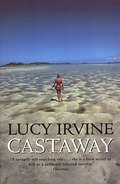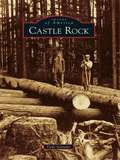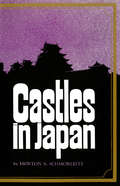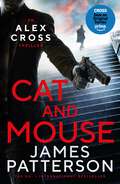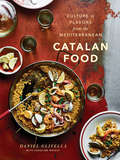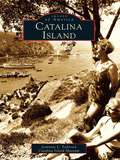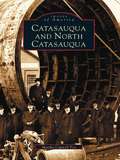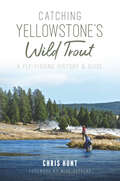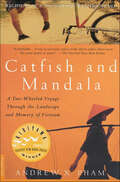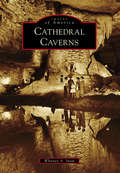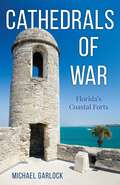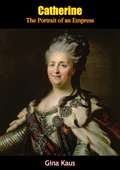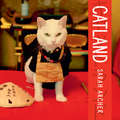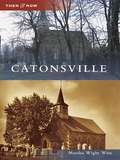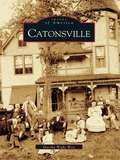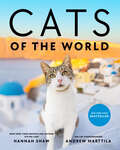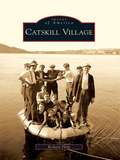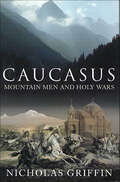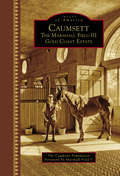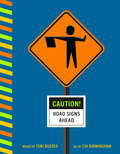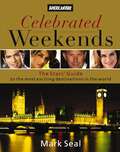- Table View
- List View
Castaway
by Lucy IrvineTHE SHOCKING STORY OF A DESERT ISLAND DREAM THAT WENT SOUR'Writer seeks "wife" for a year on tropical island.' The opportunity to escape from it all was irresistible. Lucy Irvine answered the advertisement - and found herself alone on a remote desert island with a 'husband' she hardly knew.Lucy Irvine fell in love with the seductive, if cruel, beauty of that untouched Eden, whose power to enslave and enchant her never slackened throughout the whole of her amazing adventure.Uncompromisingly candid and sometimes shocking, Castaway is her compulsively readable account of a desert island dream which threatened to turn into a nightmare of illness, thirst and personal antipathy.Now a film by Nicholas Roeg starring Amanda Donohoe and Oliver Reed,
Castle Garden and Battery Park (Images of America)
by Barry MorenoFew buildings in Manhattan have had a richer and more varied life than 200-year-old Castle Clinton, the magnificent red sandstone structure that lies in historic Battery Park. Although originally built as a fortress just before the outbreak of the War of 1812, its actual fame rests on the years when it was known worldwide as Castle Garden, a name that underlined its intimate connection with the surrounding park. Under that name, it served successively as Manhattan's preeminent public events hall and theater (1824-1855), then as America's first great landing place for millions of immigrants (1855-1890), and finally as the oldest and grandest municipal aquarium in the United States (1896-1941). Castle Garden and Battery Park invites readers to step back in time and dip into this legendary monument's dramatic story and learn how it has managed to survive into the 21st century.
Castle Rock
by Vicki SelanderEarly travelers coming up the Cowlitz River saw a large rock formation next to the river, which they named Castle Rock. It was here, nestled between the Willapa Hills and the Cascade Mountains, that William and Eliza Huntington made their homestead in 1852. Theirs and several other early land grants make up what is now the site of Castle Rock, as well as nearby homes and farms. Descendants of many early pioneer families continue to live in Castle Rock, including Pyle, Jackson, Merrill, Dougherty, Whittle, Studebaker, and others. The town and its people have survived a series of natural disasters in the 20th century, including floods, an earthquake, a Pacific hurricane, and the eruption of Mount St. Helens, each time picking up the pieces of their lives and rebuilding. With the virtual collapse of the timber industry, Castle Rock is now beginning to find its identity and ability to prosper in the 21st century.
Castles in Japan
by Morton S. SchmorleitzBehind the glossy facade of modern Japan there survive remnants-some of them surprisingly well preserved-of the country's feudal past, of warlords and fighting samurai, of shoguns and sequestered emperors, of princes and peasants. This book vividly presents the castles of Japan, more than 80 of them altogether, ranging geographically from Matsumae on the northern island of Hakkaido to Kagoshima in southern KyushuThe author brings not only an immense knowledge but also a deep feeling for Japan and things Japanese to this sensitive study, formed from both the historian's and the sightseer's perspectives. Most of the Japanese castles, he explains, were built in several amazing decades at the end of the 16th century. The Tokugawa shogunate was then consolidating its power and local lords were girding themselves for the onslaughts of enemies supplied with that recent acquisition fro the West-firearms.Castle architecture, among the most original of Japanese architectural forms, manifested a diabolically shrewd defense capability. An unwary enemy, if unwary he were, might charge into a veritable chamber of horrors-stone-dropping chutes, hidden gates, sharply-curved passageways, flooded moats, trap doors, and floor boards that squeaked to warn of an intruder's arrival. In Japanese style, many even contained special suicide courts.
Cat and Mouse (Alex Cross #4)
by James PattersonJust as Alex Cross is beginning to feel that life is good and he is finally coming out of the depression he's been in since the death of his wife, he is called to Union Station train terminal - a man is on the loose, firing at random into the swarming crowds of travellers. Psychopath Gary Soneji seems determined to go down in a blaze of glory, and he wants Alex Cross to be there. Will this be the final showdown
Cat and Mouse (Alex Cross #4)
by James PattersonJust as Alex Cross is beginning to feel that life is good and he is finally coming out of the depression he's been in since the death of his wife, he is called to Union Station train terminal - a man is on the loose, firing at random into the swarming crowds of travellers. Psychopath Gary Soneji seems determined to go down in a blaze of glory, and he wants Alex Cross to be there. Will this be the final showdown. (P)2015 Headline Digital
Catalan Food: Culture and Flavors from the Mediterranean
by Caroline Wright Daniel OlivellaCatalan cuisine authority Daniel Olivella serves historical narratives alongside 80 carefully curated Spanish food recipes, like tapas, paella, and seafood, that are simple and fresh.In proud, vibrant Catalonia, food is what brings people together—whether neighbors, family, or visitors. By the sea, over a glass of chilled vermouth and the din of happily shared, homemade Pica Pica (tapas) is where you’ll find the most authentic Catalonia. The region is known for its wildly diverse indigenous ingredients, from seafood to jamon Ibérico to strains of rice, and richly flavored cuisine that has remained uniquely Catalan throughout its complex and fraught history. In Catalan Food, the recipes are intended to be cooked leisurely and with love—the Catalan way. Featuring traditional dishes like Paella Barcelonata (Seafood Paella) and Llom de Porc Canari (Slow-roasted Pork Loin), as well as inventive takes on classics like Tiradito amb Escalivada (Spanish Sashimi with Roasted Vegetable Purees) and Amanida de Tomàquet amb Formatge de Cabra (Texas Peach and Tomato Salad with Goat Cheese), Catalan Food brings heritage into any home cook’s kitchen, where Catalonia’s cuisine was born. To know a culture, you must taste it; none is more rich and stunningly delicious than Catalonia’s.
Catalina Island
by Jeannine L. Pedersen Catalina Island MuseumThroughout its history, the 76-square-mile island of Catalina has played host to Native Americans, smugglers, otter hunters, ranchers, miners, entrepreneurs, vacationers, movie stars, and nature enthusiasts. William Wrigley Jr. (of chewing-gum fame) bought the island in 1919 and later constructed the recognizable casino building, which was never used for gambling but did become one of the best-known ballrooms in America. In the 1970s, the Wrigley family deeded 88 percent of the island to the Catalina Island Conservancy, which protects the natural state of the island and her inhabitants. Today nearly one million tourists visit annually to take in the fishing, parasailing, glass-bottomed tour boating, scuba diving, cycling, camping, galleries, shopping, and dining.
Catasauqua and North Catasauqua (Images of America)
by Martha Capwell FoxOnce among the wealthiest communities in the country, Catasauqua was the birthplace of the modern American iron and steel industry. The energy and inventiveness of industrialists such as David Thomas, J.W. Fuller, and Leonard Peckitt spurred the growth and spread the fame of the Iron Borough far beyond the Lehigh Valley. Entrepreneurs and workers flocked to Catasauqua and North Catasauqua. They filled its mansions and row houses, churches and schools, silk mills, saloons, and playing fields with families who were proud to call the "Million Dollar Town" home.Their pride is evident in the images in Catasauqua and North Catasauqua. Bustling businesses, spacious schools, cherished churches, opulent houses, big parades and public celebrations, and strong, confident faces abound in these photographs. The culmination of that pride and prosperity came in 1914, when Catasauqua welcomed the world to celebrate the seventy-fifth anniversary of the Crane Iron Works with Old Home Week. Less than ten years later, the iron business was gone, its last years recorded in extraordinary photographs. Life in Catasauqua, though harder, went on and today, the heritage of the Iron Borough days is visible everywhere in both towns-the streets, houses, and churches still loved and lived in as they were a century or more ago.
Catching Yellowstone's Wild Trout: A Fly-Fishing History and Guide (Natural History)
by Chris HuntThis history and guide to the fly-fishing waters of Yellowstone National Park is a loving homage to the region&’s iconic wild trout. Yellowstone National Park is home to some of the most storied destinations in the history of fly fishing. Casting in the Firehole River is like going back in time to when bison roamed nearly every meadow in the West. Restored to their natal streams after near extinction, native Arctic grayling can once again be plucked from icy water at the foot of breathtaking waterfalls. Meanwhile, a daylong hike into true wild country rewards an angler with a chance to catch trophy native cutthroat trout on a lonely mountain lake. In Catching Yellowstone&’s Wild Trout, local journalist and experienced angler Chris Hunt explores the rich history of these beloved and bountiful waters.</
Catfish and Mandala: A Two-Wheeled Voyage Through the Landscape and Memory of Vietnam
by Andrew X. Pham“A brilliantly written memoir in which a young Vietnamese-American uses a bicycle journey in his homeland as a vehicle to tell his eventful life story.” —Kirkus ReviewsWinner of the Kiriyama Pacific Rim Book PrizeA New York Times Notable Book of the YearWinner of the Whiting Writers’ AwardA Seattle Post-Intelligencer Best Book of the YearCatfish and Mandala is the story of a young man’s solo bicycle voyage around the Pacific Rim to Vietnam—an odyssey in pursuit of both his adopted homeland and his forsaken fatherland. Intertwined with an often-humorous travelogue is a memoir of war, escape, and ultimately, family secrets.Andrew X. Pham was born in Vietnam and raised in California. His father had been a POW of the Vietcong; his family came to America as “boat people.” Following the suicide of his sister, Pham quit his job, sold all of his possessions, and embarked on a year-long bicycle journey that took him through the Mexican desert; on a thousand-mile loop from Narita in South Korea to Kyoto in Japan; and, after five months and 2,357 miles, to Saigon.In Vietnam, he’s taken for Japanese or Korean by his countrymen; and in the United States he’s considered anything but American. A vibrant, picaresque memoir written with narrative flair and an eye-opening sense of adventure, Catfish and Mandala is an unforgettable search for cultural identity.
Cathedral Caverns (Images of America)
by Whitney A. SnowIn 1952, Jacob “Jay” Gurley explored a Marshall County, Alabama, curiosity known as Bat Cave. Amazed by its stalagmites and sheer enormity, he purchased the site and began transforming it into Cathedral Caverns, a spectacular tourist attraction that eventually became a national natural landmark in 1973 and a state park in 2000. Had it not been for Gurley’s hard work and dedication, this cave, a geological treasure of international renown, might have remained a little-known hole in the ground. His efforts impacted local and state tourism, economics, and politics. This is the story of one man and his vision.
Cathedrals of War: Florida's Coastal Forts
by Michael GarlockCathedrals of War tells the story ofFlorida&’s coastal fortifications from Amelia Island on the Florida/Georgia border, to Key West, the Dry Tortugas, an atoll midway between Key West and Havana, Cuba and Pensacola on Florida&’s west coast. Covering the colonial era to the Civil War to the late 1880s, this book explains the specific locations, designs of the forts, the strategy behind their construction, military necessity, and purpose that led to their construction, their armament and the battles they participated in.
Catherine: The Portrait of an Empress
by Gina KausTHERE have been better women than Catherine of Russia, nobler and more learned women, but history discloses no woman who combined so much of good and evil into one bewildering and gloriously successful career. Daughter of a petty German Prince, chance made her the wife of the heir to the Russian Empire. She took that nation to her heart, discarded her weakling husband, and ruled her adopted country for more than three decades with a strength and understanding it had seldom known before.No one rejoiced at the birth of Catherine. Her parents had prayed for a boy, and the little girl was soon made to feel the bitterness of their disappointment. She decided, therefore, to become a man and, when the opportunity appeared, she decide to become the greatest man in Europe. Nothing stood in the way of that determination—Catherine was quite prepared to commit murder when the occasion called for it—but she was not cruel according to the standards of her day. She was kind, open-handed; her sympathetic interest in her people was deep; and she became noted for her acts of spontaneous generosity.Gina Kaus seizes the material which this unique life affords, remolds it in the light of newly discovered documents and modern psychology, and presents for the first time a unified and congruous portrait of Catherine. The spectacular occurrences of the Empress’s reign appear here in their relative significance to her life and to European history. Catherine fulfilled the dream of her girlhood and, as Frau Kaus remarks, she died the happiest death that ever Tsar died—she died of laughter.
Catland: The Soft Power Of Cat Culture In Japan
by Sarah ArcherAn irresistible and colorful celebration of Japan’s thriving cat culture. In Japan, cats rule. And the country’s feline love affair is now a worldwide phenomenon. From cat cafés and Hello Kitty to the familiar sight of a maneki neko (“beckoning cat”) waving its paw from a shop window, cat lovers all over the world are more immersed in Japan’s cat culture than they may realize. With charming storytelling, Catland will introduce you to cats practicing to become monks, a designer who makes cat costumes inspired by the fashions of 18th-century France, and skilled craftsmen who build pieces of fine furniture precisely scaled down to suit feline customers. Packed with photographs, works of art, pop culture and folklore, Catland is the perfect gift for the cat lover in your life.
Catonsville
by Marsha Wight WiseCatonsville, a major suburb of Baltimore, retains much of its early 19th-century, genteel country-estate charm. In 1810, Charles Carroll bestowed the land that is now Catonsville upon his daughter, Mary, and her husband, Richard Caton. The Frederick Turnpike helped the area grow, and many estates and farms cultivated the community. By 1880, it was the preferred summer retreat from the heat of Baltimore City for some of Maryland's most prosperous merchants. The completion of the Catonsville Short Line Railroad in 1884 made the burg attractive to middle-income families; a diverse village was born. Highlighted in this volume are many long-gone homes, mansions, and institutions such as Castle Thunder, Ingleside, Nancy's Fancy, Catonsville Casino, Farmlands, and Arden, the centerpiece of Eden Terrace. Featured as well are monuments that still stand today: Uplands Mansion, Homewood, James Gary's Summit, Hilton, St. Mark Catholic Church, St. Charles College, Old Salem Lutheran Church, Mt. de Sales Academy, Belle Grove, numerous Victorian manors, and the early 20th-century homes that completed this hamlet.
Catonsville (Images of America)
by Marsha Wight WiseCatonsville, a major suburb of Baltimore, retains much of its early 19th-century, genteel country-estate charm. In 1810, Charles Carroll bestowed the land that is now Catonsville upon his daughter, Mary, and her husband, Richard Caton. The Frederick Turnpike helped the area grow, and many estates and farms cultivated the community. By 1880, it was the preferred summer retreat from the heat of Baltimore City for some of Maryland�s most prosperous merchants. The completion of the Catonsville Short Line Railroad in 1884 made the burg attractive to middle-income families; a diverse village was born. Highlighted in this volume are many long-gone homes, mansions, and institutions such as Castle Thunder, Ingleside, Nancy�s Fancy, Catonsville Casino, Farmlands, and Arden, the centerpiece of Eden Terrace. Featured as well are monuments that still stand today: Uplands Mansion, Homewood, James Gary�s Summit, Hilton, St. Mark Catholic Church, St. Charles College, Old Salem Lutheran Church, Mt. de Sales Academy, Belle Grove, numerous Victorian manors, and the early 20th-century homes that completed this hamlet.
Cats of Rome
by Traer ScottFrom the award-winning author of Finding Home and Rescue Cats: a dazzling collection of photographs of cats throughout the iconic city of Rome.Whether you are a cat lover, armchair traveler, or photography buff, Traer Scott’s Cats of Rome will entice you into this ancient city that is home to more than 300,000 cats. Of these, at least one-third are thought to be feral. As Roman cats are protected by law, they have the right to live where they choose in architectural ruins, parks, and neighborhoods throughout the city.In seventy-five brilliant color photographs, Rome’s feline denizens are shown as they live naturally among stunning, classical backdrops, with visual whispers of the gattaras—the often nameless and plentiful women of Rome who volunteer to care for the feral colonies. These beautiful cats are safe, cared for, and magnificent, and this keepsake volume is perfect for anyone who has visited Rome or dreams of doing so.CELEBRATED PHOTOGRAPHER: Traer Scott, award-winning photographer and animal welfare activist, turned her lens on the cats of Rome as she explored the Eternal City and sought out evidence of its estimated four thousand feral cat colonies. Through her practiced lens, these majestic felines and their breathtaking surroundings—from the Colosseum to lush cemeteries to the ruins of Porta Magica—create an irresistible travelogue for cat lovers and travel enthusiasts alike. Scott’s bestselling animal photography books include Forever Home, Radiant, and Shelter Dogs.CAT COFFEE TABLE BOOK: Several children’s books feature the wondrous cats of Rome, but this is the first photography book to showcase the beloved cat sanctuaries of this historic and uniquely beautiful European city.ITALIAN HISTORY: Each chapter showcases one of Rome’s vibrant cat colonies, with introductory text about the location, a brief bit of history, and an overview of the cat population’s roots within it. From ancient to modern Rome, this artful book offers a visual journey through a mesmerizing place.Perfect for:Cat lovers and collectors of cat photographyTravelers and armchair travelersFans of Italian culture, history, and architectureReaders who enjoy nature, animal, and travel coffee table books
Cats of the World
by Hannah Shaw Andrew MarttilaAn Instant New York Times Bestseller. Hannah“Kitten Lady” Shaw and professional cat photographer Andrew Marttila journey to thirty countries to bring you hundreds of photos and stories of cats from every corner of the world. Wife and husband team Hannah Shaw and Andrew Marttila have made cats their lives' work: they rescue and rehabilitate neonatal kittens, educate the public on cat and kitten care, and capture our feline friends' unique personalities through writing and photography. Now, in the project of their dreams, they've taken their passion for cats global. In Cats of the World, Shaw and Marttila travel across thirty countries to explore feline welfare and cat culture around the globe, documenting their travels with stunning photos and stories from each location. Journey to England's charming pubs and candle-lit cathedrals, Chile&’s vibrant produce markets and colorful hillsides, Türkiye&’s spice bazaars and ancient ruins, South Africa's bustling streets and lush mountains, and so many places in between with Shaw and Marttila as they learn from cats—and the people who love them most—that compassion is truly a universal language. <br><b>New York Times Bestseller</b></br>
Catskill Village
by Richard PhilpCatskill Village has deep roots in the long human history of the Hudson River Valley, from its native population who greeted Henry Hudson on his voyage upriver in 1609 to its early settlers. Today's village is located on the commercially advantageous landing on the Hudson River. In 1802, the Susquehanna Turnpike opened the village to the expanding western frontier, and Catskill Village became one of the most prominent commercial ports on the Hudson River. Local trades such as shipbuilding, tanning, farming, brickmaking, fishing, and tourism flourished. By the mid-20th century, the long era of prosperity had faded, only to rise phoenixlike in the past decade with an infusion of young professionals, artists, craftsmen, merchants, and those determined to save and restore the village's exceptionally rich architectural heritage.
Caucasus: Mountain Men and Holy Wars
by Nicholas GriffinWhen the Russians bombed the capital of Muslim Chechnya in 2000, a city with almost a half million people was left with barely a single building intact. Rarely since Dresden and Stalingrad has the world witnessed such destruction.The Caucasus is a jagged land. With Turkey to the west, Iran to the south, and Russia to the north, the Caucasus is trapped between the Black Sea and the Caspian Sea. If it didn't already possess the highest mountain range in Europe, the political pressure exerted from all sides would have forced the land to crack and rise. Alexander the Great, Genghis Khan, Tamerlane, Peter the Great, Hitler, and Stalin all claimed to have conquered the region, leaving it a rich, but bloody history. A borderland between Christian and Muslim worlds, the Caucasus is the front line of a fascinating and formidable clash of cultures: Russia versus the predominantly Muslim mountains. Award-winning writer Nicholas Griffin travels to the mountains of the Caucasus to find the root of today's conflict. Mapping the rise of Islam through myth, history, and politics, this travelogue centers on the story of Imam Shamil, the greatest Muslim warrior of the nineteenth century, who led a forty-year campaign against the invading Russians. Griffin follows Imam's legacy into the war-torn present and finds his namesake, the Chechen warlord Shamil Basayev, continuing his struggle. Enthralling and fiercely beautiful, Caucasus lifts the lid on a little known but crucially important area of world. With approximately 100 billion barrels of crude oil in the Caspian Sea combined with an Islamic religious interest, it is an unfortunate guarantee that the tragedies that have haunted these jagged mountains in the past will show no sign of abating in the near future.
Caumsett: The Marshall Field III Gold Coast Estate (Images of America)
by The Caumsett Foundation Marshall Field VMarshall Field III was 28 years of age and one of the richest people in the world when he came upon the idea of replicating the environment in which he had spent his youth. Raised and educated in England, Field sought the life of an English gentleman here in the United States. In 1921, Field purchased almost 2,000 acres of waterfront property on Long Island's North Shore, which would become Caumsett. Forty years later, Field's third wife, Ruth, opened bids for the right to purchase Caumsett and all that it had become. The highest bid, in excess of $5 million, came from a builder who planned to subdivide the estate and construct 700 homes. A second bid, from Robert Moses, then parks commissioner of New York State, was more than $1 million less. Ruth reflected on her life and what her late husband would have wanted. She turned to trusted adviser and confidant Adlai Stevenson and stated that she wanted to accept the lower bid. Fourteen months later, Caumsett State Park was born.
Caution! Road Signs Ahead
by Toni BuzzeoEmpower backseat passengers to become informed backseat drivers with this road sign decoder featuring 35 shaped road signs!From road signs around the neighborhood, like "School Crossing" and "Playground," to signs you zoom past on the highway, this hefty reference board book highlights and explains 35 road and highway signs for the youngest readers on the go. The shaped pages make each sign tactilely memorable, and the carefully crafted one-sentence explanations will easily guide young readers as they contextualize the world that zips past their backseat windows.
Cave Paintings
by Jairo BuitragoA young space traveler discovers art painted millennia before by a human being—just like him.Our hero travels all alone on a spaceship, through the universe, past galaxies, comets and planets to go visit his grandmother on Earth for the summer holidays. She takes him to visit an ancient cave, where he discovers handprints and drawings of unknown animals made by human beings, just like him. To top off his wonderful holiday she gives him mysterious objects which once belonged to his grandfather — paper and crayons. On the way home he draws what he saw on his travels — to the amazement of his fellow passengers.Jairo Buitrago’s thought-provoking story reminds us of what remains as everything changes. Rafael Yockteng’s fabulous art, a tribute to Stanley Kubrick’s 2001: A Space Odyssey, presents us a wonderful, diverse future in which space travel is common, though knowledge of the past is still a secret treasure to be discovered.Correlates to the Common Core State Standards in English Language Arts:CCSS.ELA-LITERACY.RL.2.1Ask and answer such questions as who, what, where, when, why, and how to demonstrate understanding of key details in a text.CCSS.ELA-LITERACY.RL.2.7Use information gained from the illustrations and words in a print or digital text to demonstrate understanding of its characters, setting, or plot.
Celebrated Weekends: The Stars' Guide to 50 of the Most Exciting Cities in the World
by Mark SealVeteran travel writer Mark Seal was tired of buying disappointing travel guides. He wanted insider information about special travel destinations?the kind of tips you'd get from the locals or people who know all the best and hippest places?like celebrities.Sixteen years and a few hundred interviews later, Seal's Celebrated Weedend feature articles?city-by-city, star-by-star investigations of the coolest places to eat, sleep, and see?have enlightened and entertained countless passengers reading American Way, American Airlines' onboard magazine. And here's the best of the best, published for the first time in one place!Inside you'll . . .Raft down roaring rivers in Kevin Costner's Aspen paradise.Dine at Elizabeth Hurley's must-try Paris bistros and brasseries.Hang in the New Orleans jazz clubs where Harry Connick Jr. grew up.Shop at Penélope Cruz's clothing boutique in Madrid.Check into the landmark Philadelphia hotel where Kevin Bacon has stayed.Grab a burger in the New York saloon that Brooke Shields has frequented since childhood.Tucked in between the essential are tantalizing insider stories from today's most exciting stars?told in their own words. It's like having your closest friend tell you all the best places to go.Whether you're a serious world explorer or an armchair traveler, Celebrated Weekends has everything you need to know to enjoy the most thrilling cities in the world.
